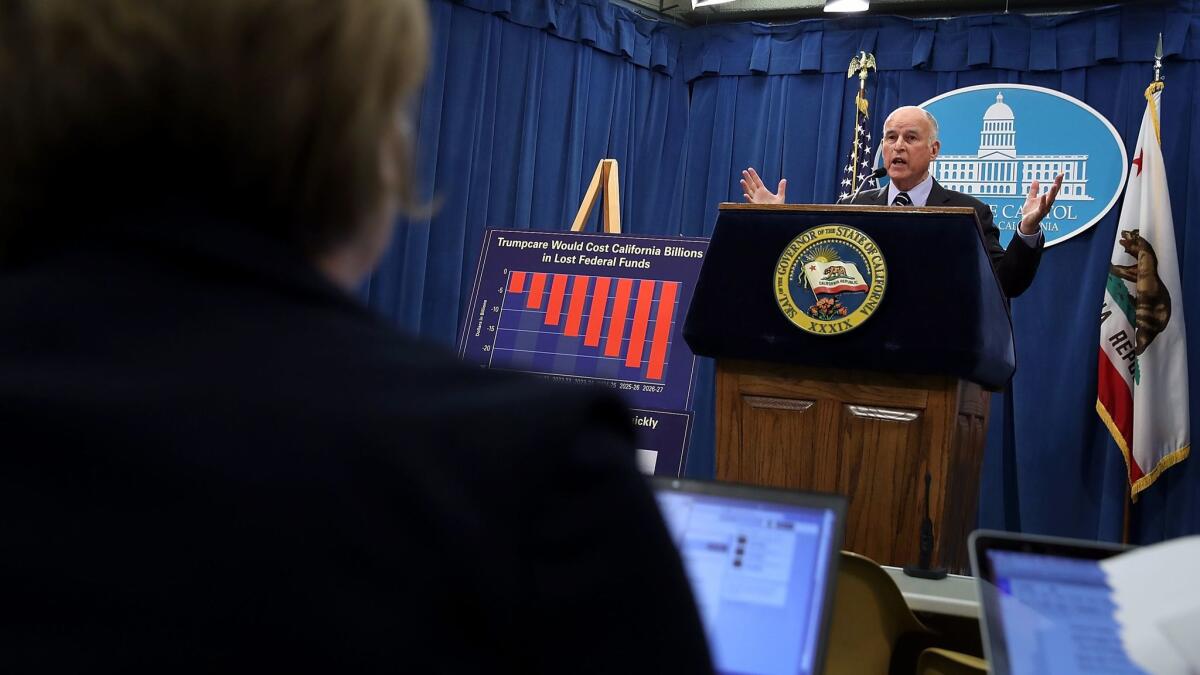Column: Political Road Map: Here’s how (and why) the state is making a $12-billion pension payment next year

If you’re a homeowner, you’ve likely had someone suggest that the easiest way to lower your long-term debt is to make an extra mortgage payment. Thanks to the miracle of compound interest, your total costs in the long run go down.
Last week, Gov. Jerry Brown essentially decided that it was worth applying the same principle to the state government’s debt for the pensions of its employees.
To do so, the governor’s newly revised state budget includes an almost $12- billion payment in the coming fiscal year to the California Public Employees’ Retirement System (CalPERS). Part of that amount is mandatory: a $5.8- billion payment required by law to cover retirement promises that were made to workers, in some cases, decades ago.
The mandatory portion is about 75% more than what the state was paying just five years ago. And for all of the complexity involved with pensions, there’s a simplicity to the math. There are only three pots of money from which to pay pension commitments: employee contributions; employer contributions (which is the state government and, thus, means taxpayer money); and investment returns on CalPERS’ $320-billion portfolio.
Those pension investments have failed to live up to expectations. Last fall, CalPERS directors officially lowered the fund’s profit predictions, which triggered a bigger invoice being sent to Brown and lawmakers. Smaller, but still serious challenges exist for the California State Teachers Retirement System (CalSTRS).
Brown’s budget team said last week that a $12-billion infusion of cash now will result in a savings to taxpayers of $11 billion over the next 20 years. A similar prepayment idea to improve the bottom line for county retirement systems has been introduced in the Legislature by state Sen. John Moorlach (R-Costa Mesa).
Though it may be fiscally prudent to do so, making an extra payment amounts to a lot of money — in this case, equal to almost 10% of total general fund revenues in the coming year, and close to double the state’s combined contribution to the University of California and Cal State University systems.
CalPERS trims its investment expectations, raising costs to taxpayers »
So where does the extra money come from? It’s a loan from an obscure surplus cash account, and not from current government services and programs. In all, $6 billion will be borrowed from the Surplus Money Investment Fund for a supersized pension payment.
“It doesn’t take from child care, it doesn’t take from any other programs,” Brown told reporters last week.
The surplus fund is managed by state Treasurer John Chiang, and is essentially money waiting to be spent by various state agencies. Now totaling $50 billion, it’s larger than ever before. The loan gets paid back through the money earmarked for debt payments under Proposition 2, the ballot measure approved by voters in 2014 that also strengthened California’s rainy-day fund.
“It reduces the burden of unfunded pension liabilities that would otherwise be passed along to future generations of Californians,” Chiang, who is running for governor, said in a statement.
To the outside observer, all of this may seem an overly complicated way of just shuffling around what — at the end of the day — are still all public funds. That’s true, though it likely earns bonus points for trying to creatively use cash that otherwise can’t be commingled.
But lawmakers probably shouldn’t celebrate their cleverness too long. Even with this extra cash, California’s pension funds face an enormous challenge over the next two decades. The proposal is unlikely to face any opposition. If anything, given how it highlights the benefit of compound interest, someone will likely start to wonder what other sources of cash could eventually be tapped to ease the state’s future pension pressures.
Follow @johnmyers on Twitter, sign up for our daily Essential Politics newsletter and listen to the weekly California Politics Podcast
ALSO:
Gov. Jerry Brown urges ‘penance’ for GOP lawmakers in Washington as he unveils a revised budget
Political Road Map: Sacramento’s closed-door dealmaking didn’t go away with Proposition 54
Updates on California politics and government
More to Read
Get the L.A. Times Politics newsletter
Deeply reported insights into legislation, politics and policy from Sacramento, Washington and beyond. In your inbox three times per week.
You may occasionally receive promotional content from the Los Angeles Times.











